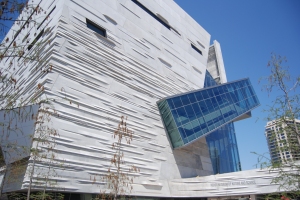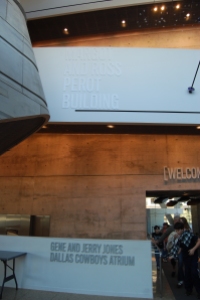The Perot Museum of Science and Nature
 A lot has changed in downtown Dallas in the last few years. There’s a big bridge that really isn’t anything special, a park built over the top of a freeway connecting to parts of downtown, and an awesome-looking new museum in the West End. While visiting home a few weeks ago, I took the chance to experience this recently opened museum.
A lot has changed in downtown Dallas in the last few years. There’s a big bridge that really isn’t anything special, a park built over the top of a freeway connecting to parts of downtown, and an awesome-looking new museum in the West End. While visiting home a few weeks ago, I took the chance to experience this recently opened museum.
It is impressive! The building is a massive modern beauty. And, as you walk up the path to the entrance you don’t have to wonder who put up the money to build it – the Perot family.
This museum is a combination of three older museums, The Science Place, the Dallas Children’s Museum and the Museum of Natural History at Fair Park. The first two contributors have completely closed since this new facility opened, making this the go-to destination for educational field trips in Dallas.
 First impressions were good with a great entrance plaza including interactive displays and engaging landscaping. The lobby was also impressive with your first glimpse of dino bones and a cool installation of H2O shaped molecule sculptures pulsing up and down as people walked under them making it a dancing water fountain.
First impressions were good with a great entrance plaza including interactive displays and engaging landscaping. The lobby was also impressive with your first glimpse of dino bones and a cool installation of H2O shaped molecule sculptures pulsing up and down as people walked under them making it a dancing water fountain.
From there we rode an escalator to the second to last exhibition floor. This led me to believe it would have a path to follow with one exhibit leading to the next. After all, this helps with moving people, telling a story and teaching. I assumed wrong. True, the first exhibit was just off this escalator ride, but there was no clear flow to the exhibits or to the museum as a whole making it at times crammed, congested and confusing.
I also assumed that the museum would follow some kind of patter like the universe and how it works to primordial life and prehistoric life to modern life followed by humans and human achievement. Not the case. It sort of skips around a bit. There’s a hall about the universe cramming a whole bunch into a small space. A great hall about dinosaurs. An odd, out-of-the-way balcony exhibit about birds, an exhibit hall about animals, one about humans, one about energy and rocks, etc.
Things I think they did right
 Lots of interactive, hands-on exhibits.
Lots of interactive, hands-on exhibits.- A great dinosaur hall. If you’ve followed my blog for a while, you know I like a good dinosaur museum. There is a full “skeleton” on exhibit of the largest dinosaur fossil ever found with the real vertebrae there on display.
- A fascinating exhibit hall all about the human body with lots of hands-on learning. There is even a lab where kids can get hands-on with lab techs showing them how to put samples on slides, use microscopes and more.
- Great design of the building using it as an exhibit. They designed it with different Texas ecosystems as roof gardens and designed it to recycle rain water and use solar energy for all of their hot water.
Things I think they did wrong
 Sponsors names seemed just as important if not more important than some things. Every hall was sponsored and the benefactor’s names were huge, almost in a bragging manner.
Sponsors names seemed just as important if not more important than some things. Every hall was sponsored and the benefactor’s names were huge, almost in a bragging manner.- Some hands-on exhibits were not designed to last. Several things had broken or would soon. The designers didn’t consider how much wear and tear things would get and the museum has only been open a few months.
- The exhibit about energy described really well the use of petroleum and gas and how it is found (the exhibit is sponsored by an oil company), but very little space discussing alternative fuels, energy and so on. Even in conservative Texas it is possible to talk about these without going too liberal or hippie. There was even room if they hadn’t spent so much space on a 10-times-larger-than-life drill head that they seemed to brag about all over. It simply wasn’t necessary.
- School groups were on free reign meaning most of them weren’t learning a darn thing. School kids were also overloading some of the exhibits, elevators and walking spaces. To make the museum an effective educational tool, the groups should be led through the exhibits by docents or teachers. Otherwise it is just a free day spent adding wear and tear to the museum exhibits and infrastructure.
I don’t know if I’ll ever go back, but it is a nice museum. I just wonder why they got rid of some of the great exhibits at The Science Place and what they’ll do with that building. Have any of you been to a museum recently? What do you think was done right or could have been better?




blueevents
Reblogged this on blue-events.